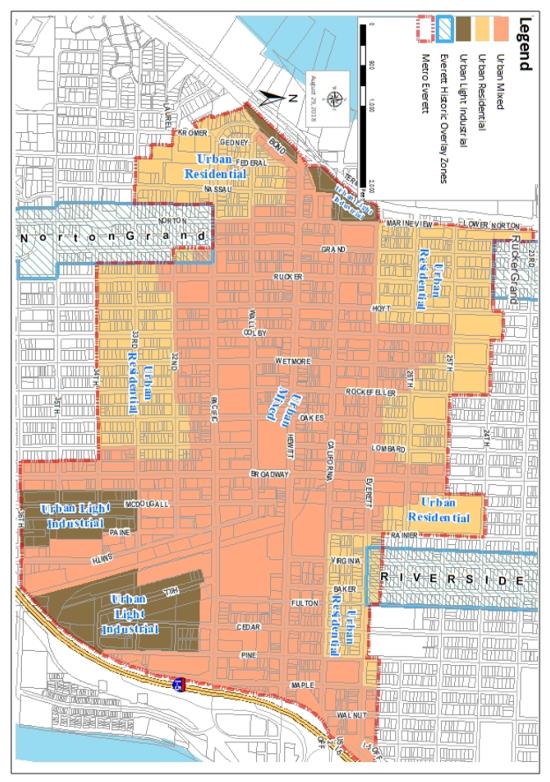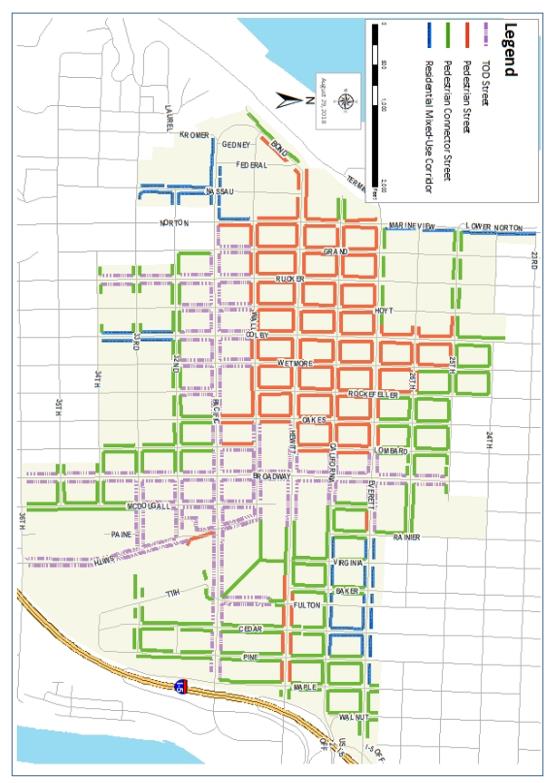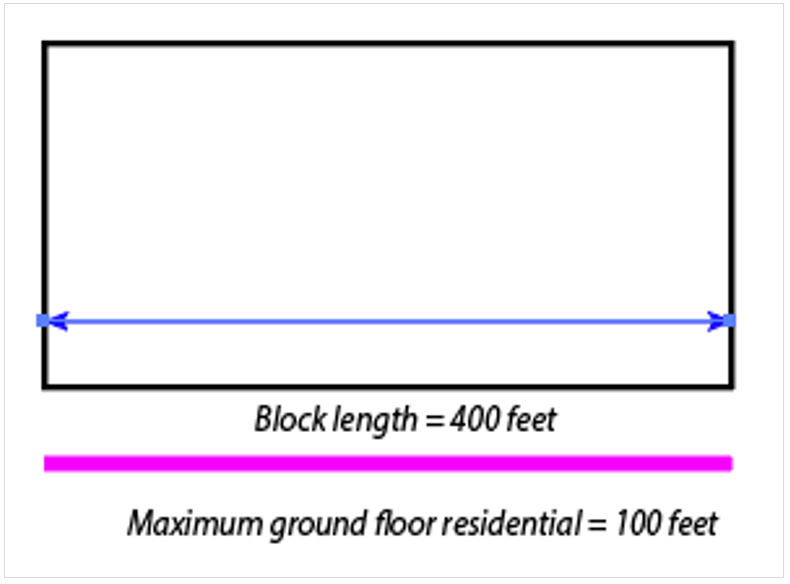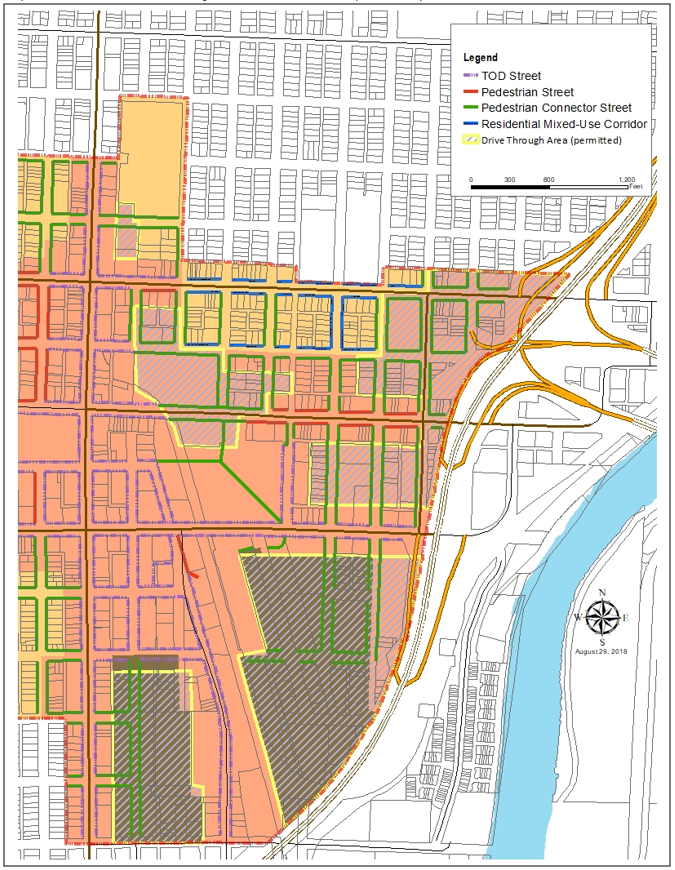Chapter 19.19
METRO EVERETT USES
Sections:
19.19.020 Establishment of allowable uses.
19.19.025 Use of basement or other building spaces in the urban mixed zone.
19.19.030 Metro Everett use table.
19.19.040 Permitted drive-through areas in Metro Everett.
19.19.050 Review criteria for administrative use and conditional use permits.
19.19.060 Modification of development standards.
19.19.010 Applicability.
A. Introduction. All uses and structures proposed on properties within Everett’s metropolitan center (“Metro Everett”) located in the urban residential (“UR”), urban mixed (“UM”) and urban light industrial (“ULI”) zones shall be subject to the uses and other requirements of this chapter.
B. Metro Everett Zoning Map. The zoning map for Metro Everett is shown in Map 19-1 and is incorporated into the map or set of maps for zoning in Everett as set forth in Chapter 19.02. Interpretation of zoning boundaries shall follow Chapter 19.02.
C. Overlay Zones. There are two historic overlays (Norton-Grand and Riverside) within the UR, UM and ULI zones. In addition, this chapter also includes designation of street types, which function as an overlay for restricting certain uses. For additional restrictions and standards applicable to overlay zones, refer to the applicable section of the Everett zoning code.
D. Street Type Designations Map. Streets within Metro Everett may have one of four street types designated: transit-oriented development (“TOD”) street, pedestrian street, pedestrian connector street and residential mixed-use corridor. These street types function as a design and use overlay. Use restrictions by street type are included in this chapter. Please refer to Chapter 19.20 for additional development standards for these street types.
Map 19-1: Metro Everett Zoning Map
Map 19-2: Street Type Designations
(Ord. 3615-18 § 1 (Exh. 1) (part), 2018)
19.19.020 Establishment of allowable uses.
A. General Provisions.
1. Any one or more land uses identified as being allowed within a particular zone may be established on any parcel within that zone, subject to the planning permit required for the use, and compliance with all other applicable requirements of the Everett zoning code.
2. Where a project is proposed for development with two or more of the land uses listed in the use table, the overall project shall be subject to the highest review process (e.g., III is higher than II) for any of the proposed uses.
3. Accessory Uses. See Chapter 19.39.
4. Home Occupations. See Chapter 19.41.
B. Unlisted Uses.
1. Similar in Nature and Impact. If a use is not listed but is similar in nature and impact to a use that is listed in Table 19-1, the planning director may interpret the use as permitted in accordance with the review process outlined in Title 15.
2. Not Similar in Nature or Impact. If a use is not listed and cannot be interpreted as similar in nature or similar in impact to a use that is listed in Table 19-1, the use is deemed prohibited.
C. Use Restrictions by Street Type.
1. A use that is allowed in Table 19-1 may be further restricted based on whether the property fronts on a designated street type. The restriction based on street type designation could apply to the entire property or to ground floor uses.
2. Corner Lots. For corner lots with more than one street type designation, the most restrictive street type designation applies to that portion of the lot measured one hundred feet in depth from the lot line adjoining the designation. See Figure 1 below for how to apply this requirement.
Figure 1: Corner Lots
3. Ground Floor Residential on TOD Streets. In order to create vibrant, livable communities around high-capacity transit nodes, a mixture of uses in close proximity is a vital component. To ensure that the pedestrian realm along the public frontage is active, residential use on the ground floor of block street frontage cannot exceed twenty-five percent of the street frontage unless a modification is approved by the planning director. See Figure 2 below for how this is calculated.
Figure 2: Ground Floor Residential on TOD Street
(Ord. 3615-18 § 1 (Exh. 1) (part), 2018)
19.19.025 Use of basement or other building spaces in the urban mixed zone.
A. Purpose. The purpose of this section is to allow basements or other spaces in existing buildings in the urban mixed (UM) zone to be considered for uses that are not otherwise permitted, but which, if properly designed and managed, would not create unacceptable impacts on surrounding properties or the downtown area in general. Other spaces, in addition to basements in existing buildings that, due to their location or configuration, are not readily usable for permitted uses, as determined by the planning director, may be considered using the process described herein. This process differs from the unlisted use process listed in Section 19.020.B in that uses that are not specifically authorized in the UM zone may be considered using the process described herein.
B. Review Process.
1. Any request to allow a use that is not otherwise permitted in the UM zone shall be reviewed using Review Process II.
2. Review Criteria. The following criteria shall be used as the basis for approving, denying, or conditionally approving a request to allow the use of a basement space, or other space as provided herein, for a use not otherwise permitted in the UM zone.
a. Traffic generated by the proposed use.
b. Noise generated by the proposed use.
c. Impacts from odor, vibration, dust or other nuisances.
d. Aesthetic character and quality of the proposed use.
e. Public safety impacts.
f. Compliance with building and fire codes.
g. Hours of the day of proposed use or activity.
h. Proposed management and operational procedures to minimize and mitigate potential impacts.
i. Other factors not specified herein that would create a conflict with the uses that are permitted in the B-3 zone.
3. Action. Any proposal that gives the outward appearance of a use or activity that is incompatible with the intent and purpose of the UM zone shall be denied. The city shall retain the right to revoke a permit issued under this section that fails to comply with any conditions of approval of said permit, or which operates in a manner inconsistent with representations made in the application, pursuant to Chapter 1.20. (Ord. 3615-18 § 1 (Exh. 1) (part), 2018)
19.19.030 Metro Everett use table.
Land uses which are listed in Table 19-1 shall be permitted subject to the review process listed in the table for a specific use in a particular zone. If a use is not listed, please refer to Section 19.020.B regarding unlisted uses. See Map 19-2 for street type designations. Criteria for the evaluation of administrative use and conditional use permits assigned in Table 19-1 are set forth in Section 19.19.050.
|
TABLE 19-1: USE TABLE |
||||
|---|---|---|---|---|
|
|
ZONING CLASSIFICATION |
SPECIAL REGULATIONS |
||
|
LAND USE |
UR |
UM |
ULI |
|
|
RESIDENTIAL USES |
||||
|
Bed and breakfast inns |
A |
P |
A |
|
|
Dormitory |
P |
P |
A |
1. TOD streets: except in the UR zone, residential use on the ground floor cannot exceed 25% of the street frontage of the block |
|
Dwelling, single-family attached |
P |
N |
N |
2. TOD or pedestrian streets: prohibited use |
|
Dwelling, single-family detached |
N* |
N |
N |
3. * This use is allowed for property within a historic overlay zone |
|
Dwelling unit, accessory |
A |
N |
N |
|
|
Dwelling, cottage housing |
P |
N |
N |
4. TOD streets: except in the UR zone, residential use on the ground floor cannot exceed 25% of the street frontage of the block |
|
Dwelling, duplex |
N* |
N |
N |
5. * This use is allowed for property within a historic overlay zone |
|
Dwelling, micro-housing |
P |
P |
A |
6. TOD streets: except in the UR zone, residential use on the ground floor cannot exceed 25% of the street frontage of the block |
|
Dwelling, multifamily (3+ units) |
P |
P |
A |
7. TOD streets: except in the UR zone, residential use on the ground floor cannot exceed 25% of the street frontage of the block |
|
Family home (day care or adult) |
P |
P |
A |
8. TOD streets: except in the UR zone, residential use on the ground floor cannot exceed 25% of the street frontage of the block |
|
Group homes, Class I |
P |
P |
A |
9. TOD or pedestrian streets: prohibited use on the ground floor |
|
Group homes, Class II |
N |
C |
C |
10. TOD or pedestrian streets: prohibited use on the ground floor |
|
Group housing, including supportive housing, temporary housing (temporary shelter home), assisted living facility, congregate care facility, convalescent or nursing home, or enhanced service facility |
A |
P |
A |
11. TOD or pedestrian streets: prohibited use on the ground floor |
|
Live/work unit |
A |
P |
P |
|
|
Rooming house |
P |
P |
A |
12. TOD or pedestrian streets: prohibited use on the ground floor |
|
Secure community transition facility |
N |
N |
C |
|
|
Short-term rentals |
P |
P |
A |
|
|
Uses, accessory to permitted principal uses including home occupations |
P |
P |
P |
|
|
COMMERCIAL USES |
||||
|
Adult use business |
N |
N |
N |
|
|
Adult retail |
N |
N |
N |
|
|
Alcohol production, micro - e.g., micro-brewery, micro-distillery, micro-winery |
A |
P |
P |
13. UR zone: a) Permitted only on designated residential mixed-use corridor or TOD streets b) The use must be located on the ground floor of a residential mixed-use development with no less than 50% of the gross floor area used for single-family or multifamily residential uses |
|
Convention center |
N |
A |
C |
|
|
Day care center, commercial |
C |
P |
P |
|
|
Entertainment and recreation - enclosed in building (e.g., theater, fitness facility) |
A |
P |
P |
14. TOD or pedestrian streets: Teen clubs and private clubs are a prohibited use on the ground floor 15. UR zone: a) Permitted only on designated residential mixed-use corridor or TOD streets b) The use must be located on the ground floor of a residential mixed-use development with no less than 50% of the gross floor area used for single-family or multifamily residential uses |
|
Entertainment and recreation - not enclosed (e.g., amusement, outdoor arena) |
N |
C |
A |
|
|
Food or beverage establishment |
A |
P |
P |
16. Drive-through facilities: allowed only in those areas identified on Map 19-3 17. UR zone: a) Permitted only on designated residential mixed-use corridor or TOD streets b) The use must be located on the ground floor of a residential mixed-use development with no less than 50% of the gross floor area used for single-family or multifamily residential uses |
|
Lodging |
N |
P |
A |
|
|
Marijuana - retailer |
N |
P |
P |
18. See Chapter 39 for specific zoning regulations and limitations |
|
Offices - excluding clinics, social or human service facility, community services |
A |
P |
P |
19. Drive-through facilities: allowed only in those areas identified on Map 19-3 20. UR zone: a) Permitted only on designated residential mixed-use corridor or TOD streets b) The use must be located on the ground floor of a residential mixed-use development with no less than 50% of the gross floor area used for single-family or multifamily residential uses |
|
Offices - clinics, social or human service facility, community services |
N |
A |
A |
21. TOD or pedestrian streets: clinics, social or human service facility, or community services are a prohibited use on the ground floor a) Government public health agency uses providing clinical services shall be deemed to be a permitted use on the ground floor within the UM or ULI zone b) Health events on a property within the UM or ULI zone providing clinical health services to the general public, not exceeding three days in duration and occurring not more than once every 90 days, shall be exempt from the prohibition of clinics on the ground floor |
|
Parking, commercial - applicable if principal use |
N |
A |
A |
22. Surface parking lots prohibited as a principal use |
|
Retail sales and service - Non-auto-dependent |
A |
P |
P |
23. Drive-through facilities allowed only in those areas identified on Map 19-3 24. TOD or pedestrian streets: tattoo parlors, body piercing, pawnshops, secondhand stores, thrift stores, and junk stores are a prohibited use on the ground floor 25. UR zone: a) Permitted only on designated residential mixed-use corridor or TOD streets b) The use must be located on the ground floor of a residential mixed-use development with no less than 50% of the gross floor area used for single-family or multifamily residential uses |
|
Retail sales and service - auto-dependent |
N |
A |
P |
26. TOD or pedestrian streets: prohibited use 27. Drive-through facilities: allowed only in those areas identified on Map 19-3 |
|
Storage, commercial - enclosed in building (e.g., mini-storage) |
N |
A |
P |
28. TOD or pedestrian streets: prohibited use on the ground floor 29. Prohibited use on the ground floor in the UM zone |
|
Storage, commercial - not enclosed in building (e.g., boat or RV storage) |
N |
N |
P |
30. TOD or pedestrian streets: prohibited use |
|
Uses, accessory to permitted principal uses |
P |
P |
P |
|
|
Veterinary clinic or animal day care - limited to small animal |
N |
A |
P |
31. TOD or pedestrian streets: prohibited use on the ground floor 32. UR zone: a) Permitted only on designated residential mixed-use corridor or TOD streets b) The use must be located on the ground floor of a residential mixed-use development with no less than 50% of the gross floor area used for single-family or multifamily residential uses |
|
Veterinary clinic or commercial kennels - large animal or commercial kennels |
N |
N |
A |
33. TOD or pedestrian streets: prohibited use on the ground floor |
|
INDUSTRIAL USES |
||||
|
Aggregates extraction |
N |
N |
N |
|
|
Freight terminal |
N |
N |
P |
34. TOD or pedestrian streets: prohibited use |
|
Heavy industrial, manufacturing, or assembly |
N |
N |
N |
|
|
Heliport |
N |
C |
C |
|
|
Light industrial, manufacturing, or assembly |
N |
C |
P |
35. TOD or pedestrian streets: prohibited use on the ground floor |
|
Marijuana - producer or processor |
N |
N |
A |
36. TOD or pedestrian streets: prohibited use on the ground floor 37. See Chapter 39 for specific zoning regulations and limitations |
|
Marine terminal |
n/a |
|
||
|
Railway facilities |
N |
N |
C |
|
|
Storage yard |
N |
N |
A |
38. TOD or pedestrian streets: prohibited use |
|
Warehousing and distribution |
N |
A |
P |
39. TOD or pedestrian streets: prohibited use on the ground floor 40. Pedestrian connector and unclassified streets: use may not occupy the front 20 feet of any ground floor street frontage in the UM zone |
|
Uses, accessory to permitted principal uses |
P |
P |
P |
|
|
PUBLIC, INSTITUTIONAL AND QUASI-PUBLIC USES |
||||
|
Cemetery |
N |
N |
N |
|
|
Community garden |
P |
P |
P |
|
|
Food bank |
N |
A |
P |
41. TOD or pedestrian streets: prohibited use on the ground floor |
|
Government - limited point of service (e.g., public works yards, fire station, vehicle storage, etc.) |
C |
C |
P |
42. TOD or pedestrian streets: public works yards or vehicle storage prohibited use |
|
Government, administrative and service |
C |
P |
A |
|
|
Government, correctional facility |
N |
C |
N |
43. TOD or pedestrian streets: prohibited use 44. Jails and correctional facilities restricted to the four-block area bounded by Wall on the north, Pacific on the south, Colby on the west and Lombard on the east |
|
Hospitals |
C |
A |
C |
|
|
Parks |
P |
P |
P |
45. Permitted use if park master plan approved by Everett city council |
|
Religious facility and places of worship |
C |
P |
A |
46. TOD or pedestrian streets: prohibited use on the ground floor |
|
Social or human service facility |
N |
A |
A |
47. TOD or pedestrian streets: prohibited use on the ground floor |
|
Schools (public and private) - institutions of higher education |
N |
P |
A |
|
|
Schools (public and private) - elementary, middle and high schools |
C |
P |
C |
|
|
Solid waste transfer station - including hazardous waste treatment and storage |
N |
N |
A |
48. TOD or pedestrian streets: prohibited use |
|
Transit and bicycle facilities - single bus stop with or without shelter - bike rack/repair station |
P |
P |
P |
|
|
Transit station - where routes converge for transfers with more than one shelter |
N |
A |
A |
|
|
Transportation facilities of statewide significance |
C |
A |
A |
|
|
Utilities—minor above ground facilities |
P |
P |
P |
|
|
Utilities—major above ground facilities |
C |
A |
A |
|
|
Uses, accessory to permitted principal uses |
P |
P |
P |
|
|
MISCELLANEOUS USES |
||||
|
Agriculture, industrial |
N |
N |
C |
49. TOD or pedestrian streets: prohibited use |
|
N |
N |
N |
|
|
|
Agriculture, greenhouse or nursery |
N |
N |
A |
50. TOD or pedestrian streets: prohibited use |
|
Assembly, community center |
C |
P |
P |
|
|
Clubs, lodges, similar uses |
C |
P |
A |
51. TOD streets: prohibited use on the ground floor 52. TOD or pedestrian streets: teen clubs and private clubs are a prohibited use on the ground floor |
|
Marina |
n/a |
|
||
|
Uses, accessory to permitted principal uses |
P |
P |
P |
|
|
Key to Districts: |
Key to Review Process: |
|---|---|
|
UM = Urban Mixed |
P = Permitted (REV I) |
|
UR = Urban Residential |
A = Administrative Use—Subject to public notice and discretionary approval (REV II) |
|
ULI = Urban Light Industrial |
C = Conditional Use Permit—Subject to hearing and approval (REV III) |
|
|
N = Not allowed |
(Ord. 3615-18 § 1 (Exh. 1) (part), 2018)
19.19.040 Permitted drive-through areas in Metro Everett.
Drive-through facilities are not allowed on streets designated as transit-oriented development (TOD) or pedestrian; not allowed in the UR zone; and limited to those areas shown in Map 19-3.
Map 19-3: Permitted Drive-Through Areas in Metro Everett (blue hatch)
(Ord. 3615-18 § 1 (Exh. 1) (part), 2018)
19.19.050 Review criteria for administrative use and conditional use permits.
Land uses subject to administrative use (REV II review process) or conditional use permit (REV III review process) shall consider the following evaluation criteria for the use as a basis for approving, disapproving or approving with modifications a proposed use.
A. The need of the neighborhood, district or city for the proposed use.
B. The adequacy of streets, utilities and public services required to serve the proposed use.
C. The impact of traffic and parking generated by the proposed use on the surrounding area, pedestrian circulation and public safety; and the ability of the proponent to mitigate such potential impacts.
D. Compatibility of proposed structures and improvements with surrounding properties, including the size, height, location, setback and arrangements of all proposed buildings and facilities, especially as they relate to light and shadow impacts on more sensitive land uses and less intensive zones.
E. The number, size and location of signs, especially as they relate to more sensitive land uses.
F. The landscaping, buffering and screening of buildings, parking, loading and storage areas, especially as they relate to more sensitive land uses.
G. The generation of nuisance irritants such as noise, smoke, dust, odor, glare, visual blight or other undesirable impacts.
H. Consistency with the goals and policies of the Metro Everett subarea plan for the area and land use designation in which the property is located.
I. Consistency with the evaluation criteria for specific uses outlined in Section 41.150.D, if applicable. (Ord. 3615-18 § 1 (Exh. 1) (part), 2018)
19.19.060 Modification of development standards.
An applicant may propose and the planning director, using the review process described in EMC Title 15, Local Project Review Procedures, may allow an applicant to deviate from the following standards of this chapter:
A. Special regulations limiting ground floor uses in Table 19-1.
B. Special regulations requiring residential mixed-use development to have no less than fifty percent of the ground floor area be used for single-family or multifamily residential use in the UR zone.
For the criteria used for consideration of a request, please see Section 19.20.900. (Ord. 3615-18 § 1 (Exh. 1) (part), 2018)


